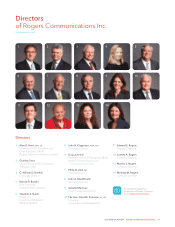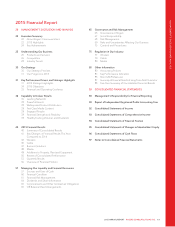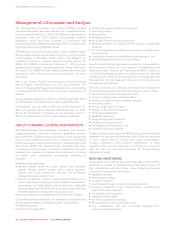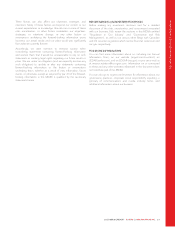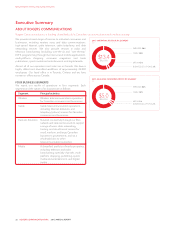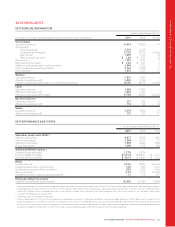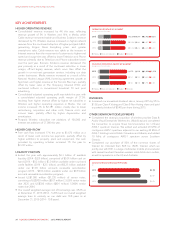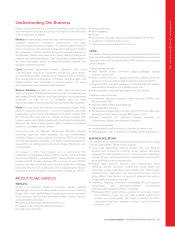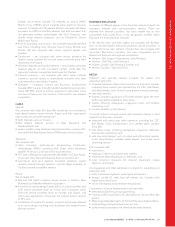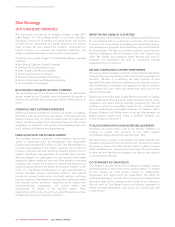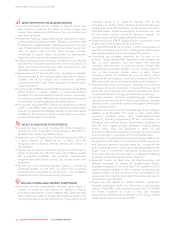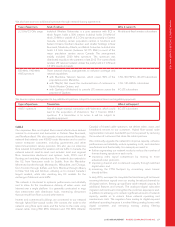Rogers 2015 Annual Report Download - page 29
Download and view the complete annual report
Please find page 29 of the 2015 Rogers annual report below. You can navigate through the pages in the report by either clicking on the pages listed below, or by using the keyword search tool below to find specific information within the annual report.
MANAGEMENT’S DISCUSSION AND ANALYSIS
Eastlink, all of whom operate LTE networks, as well as WIND
Mobile Corp. (WIND), which currently owns spectrum licences
required to operate an LTE network. We also compete with these
providers on HSPA and GSM networks and with providers that
use alternative wireless technologies, like Wi-Fi “hotspots” and
mobile virtual network operators, such as President’s Choice
Mobile and Primus.
• Product, branding, and pricing — we compete nationally with Bell
and Telus, including their discount brands Virgin Mobile and
Koodo. We also compete with various regional players and
resellers.
• Distribution — we compete with other service providers for
dealers, prime locations for our own stores, and third-party retail
distribution shelf space.
• Wireless networks and handset devices — consolidation amongst
regional players, or with incumbent carriers, could alter the
regional or national competitive landscapes for Wireless.
• Inbound roaming — we compete with other major national
carriers to provide service to international operators who have
customers who roam while in Canada.
• Spectrum — Innovation, Science and Economic Development
Canada (ISED Canada, formerly Industry Canada) has announced a
future 600 MHz spectrum auction, expected to take place in the
next two to three years. The outcome of this auction may increase
competition.
CABLE
Internet
We compete with other ISPs that offer residential and commercial
high-speed Internet access services. Rogers and Fido high-speed
Internet services compete directly with:
• Bell’s Internet service in Ontario;
• Bell Aliant’s Internet services in New Brunswick and
Newfoundland; and
• various resellers using wholesale telecommunication company DSL
and cable Third-Party Internet Access (TPIA) services in local markets.
Television
We compete with:
• other Canadian multi-channel Broadcasting Distribution
Undertakings (BDUs) including Bell, Shaw, other alternative
satellite TV services, and Internet Protocol television;
• OTT video offerings through providers like Netflix, YouTube, Apple,
shomi, and other channels streaming their own content; and
• over-the-air local and regional broadcast television signals
received directly through antennas, and the illegal reception of
US direct broadcast satellite services.
Phone
We compete with:
• Bell and Bell Aliant’s wireline phone service in Ontario, New
Brunswick, and Newfoundland and Labrador;
• Incumbent Local Exchange Carrier (ILEC) local loop resellers and
VoIP service providers (such as Primus and Comwave), other
VoIP-only service providers (such as Vonage and Skype), and
other voice applications riding over the Internet access services
of ISPs; and
• substitution of wireline for wireless products (commonly referred
to as cord-cutting), including mobile phones and wireless home
phone products.
BUSINESS SOLUTIONS
A number of different players in the Canadian market compete for
enterprise network and communications services. There are
relatively few national providers, but each market has its own
competitors that usually focus on the geographic markets where
they have the most extensive networks.
In the wireline voice and data market, we compete with facilities-
and non-facilities-based telecommunications service providers. In
markets where we own network infrastructure, we compete with
incumbent fibre-based providers. Our main competitors are as
follows, but there are also regional competitors:
• Ontario – Bell, Cogeco Data Services, and Allstream;
• Quebec – Bell, Telus, and Videotron;
• Atlantic Canada – Bell Aliant and Eastlink; and
• Western Canada – Shaw and Telus.
MEDIA
Television and specialty services compete for viewers and
advertisers with other:
• Canadian television stations that broadcast in their local markets,
including those owned and operated by the CBC, Bell Media,
and Shaw Media, some of which have greater national coverage;
• specialty channels;
• distant Canadian signals and US border stations, given the time-
shifting capability available to subscribers;
• media, including newspapers, magazines, radio, and outdoor
advertising; and
• content available on the Internet.
Our radio stations compete mainly with individual stations in local
markets, but they also compete:
• nationally with other large radio operators, including the CBC,
Bell Media, Corus Entertainment, and satellite radio operator
Sirius XM;
• with other media, including newspapers, magazines, television,
and outdoor advertising; and
• with new technologies, such as online web information services,
music downloading, portable media players, and online music
streaming services.
TSC competes with:
•retailstores;
• catalogue, Internet, and direct mail retailers;
• infomercials that sell products on television; and
• other television channels, for channel placement, viewer
attention, and loyalty.
Our magazines and other publications compete for readership and
advertisers with:
• other Canadian magazines, both digital and printed;
• foreign, mostly US, titles that sell directly into Canada, both
digital and printed; and
• online information and entertainment websites.
Competition in Sports Entertainment includes other:
• televised and online sports programming;
• Toronto professional teams, for attendance at Toronto Blue Jays
games;
• Major League Baseball teams, for Toronto Blue Jays players and fans;
• local sporting and special event venues; and
• professional sports teams, for merchandise sales revenue.
2015 ANNUAL REPORT ROGERS COMMUNICATIONS INC. 27


